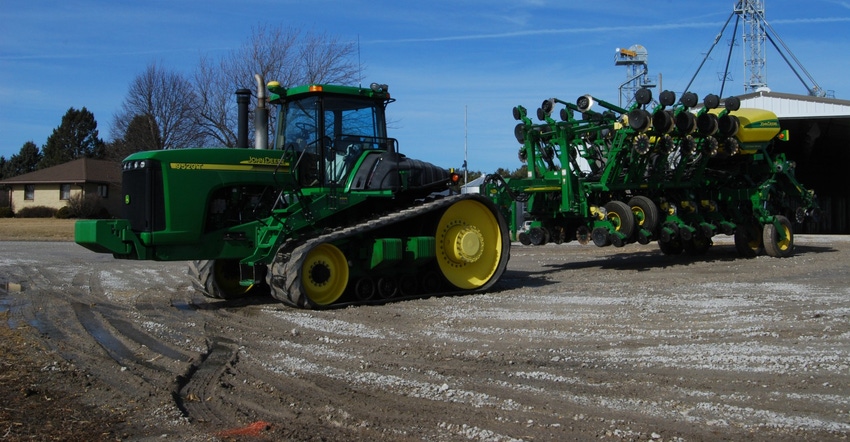
With weather finally warming up, farmers are beginning to apply anhydrous ammonia in central and southern Iowa this week. Some corn will be planted by end of the week — if soils continue to warm and it doesn’t rain.
USDA’s latest Weekly Crop Progress Report, for the week ended April 22, showed no corn planted in Iowa. Iowa’s five-year average shows 11% of the state’s corn acreage is usually planted by now. Illinois farmers have 4% of that state’s 2018 corn crop planted as of April 22, compared to a five-year average of 20%. Like Iowa, Minnesota has no corn planted vs. a 13% average for the past five years.
U.S. corn planting now 5% complete
Nationwide, USDA rated corn planting as of April 22 at 5% complete. That compares to a five-year average of 14%.
“As of April 23 here in central and southern Iowa, we’ve missed most of the snow farmers in northern Iowa received this past month,” says Joey Dunlap, a Warren County farmer. “In recent years, we would have had most all our corn planted by now. Not this year. We think maybe we can finish planting by mid-May, if we don’t get our usual spring rains. But we do need the rain. Tiles are barely running; ponds are low.”
Corn planting well behind average
Another round of cold, wet weather and significant snowfall again kept Iowa farmers from the field for much of the past week. “Iowa is now well behind the five-year average of 11% of corn planted by April 22,” notes Mike Naig, Iowa ag secretary. “Starting late last week, we began getting more seasonal weather, allowing some farmers in southern Iowa to begin spring fieldwork and do some corn planting. Hopefully, we’ll continue to see warmer and dryer weather so farmers across the state can get in the fields and start spring planting.”
The complete weekly Iowa Crop Progress and Weather Report is on the Iowa Department of Agriculture and Land Stewardship website iowaagriculture.gov or on USDA’s site nass.usda.gov/ia. The report summary follows.
Crop report
Last week began with below-normal temperatures. Counties in the northern half of Iowa received snow at midweek before temperatures warmed to near normal by week’s end. Statewide there were 1.5 days suitable for fieldwork for the week ending April 22, says USDA’s National Ag Statistics Service. When field conditions allowed, farmers applied some anhydrous ammonia and dry fertilizer, and seeded some oats. There were a few scattered reports of corn being planted in southern Iowa.
Southern Iowa needs rain
Topsoil moisture for Iowa rated 3% very short, 7% short, 74% adequate and 16% surplus. Subsoil moisture rated 4% very short, 13% short, 72% adequate and 11% surplus. Northern Iowa has received an abundance of snow, while southern Iowa needs precipitation. South-central Iowa is the driest area.
Of the expected 2018 oat crop, 23% has been planted as of April 22, almost two weeks behind last year and the five-year average. Below-normal temperatures have delayed oat emergence, with just 1% of the crop being reported as emerged. That’s the lowest level for oat emergence at this time of year since 2001.
Extended winter conditions have delayed pasture development. Calving losses have been reported as higher than normal in areas of northern Iowa.
Weather summary
According to Michael Timlin, regional climatologist at the Midwestern Regional Climate Center, temperatures were well below normal, with precipitation totals running slightly below normal in the north and well below normal in the south. Average temperatures were 10 to 20 degrees below normal for the week ending April 22. Minimum temperatures dropped below freezing for much of the week and then remained above freezing over the weekend. This helped to allow soil temperatures to warm late in the week.
Soil temperatures for the week were mostly in mid to upper 40s except in northwest Iowa April 22. Maximum temperatures averaged in the 40s for the northern half of the state and low to mid-50s for the southern half. Coldest reading in Iowa was at Waukon on April 19 when the mercury dropped to 8 degrees. Warmest readings were in low to mid-60s on April 21-22 — topped by 67 degrees at Davenport on April 22.
Wetter in northern Iowa
Precipitation totals ranged from little or nothing in the south to more than an inch at a handful of stations in northern Iowa. Hampton recorded 1.82 inches, well more than the next closest station. With just a few exceptions, the precipitation totals were below normal for the seven-day period. Snow was recorded at the morning observations on the April 16 and 19 in northern Iowa. The largest snow totals were about a foot, although Forest City in Winnebago Count, easily topped that with 22 inches of snow, 12 inches April 16 and 10 inches April 19.
About the Author(s)
You May Also Like




